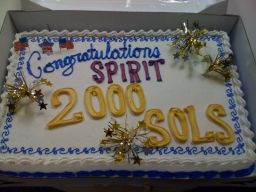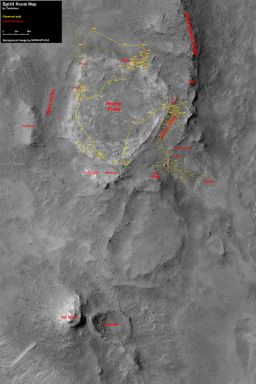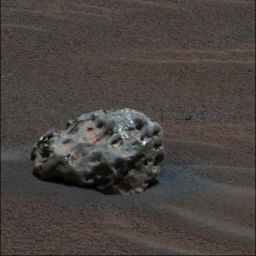A.J.S. Rayl • Aug 31, 2009
Mars Exploration Rovers Update: Spirit Celebrates 3 Martian Years, Opportunity Finds Blockbuster in Block Island
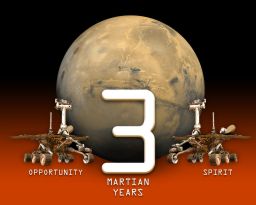
Three Mars years
Sol 2008 -- August 26, 2009 for Spirit and September 16, 2009 for Opportunity -- marks three Martian years of explortation for the twin robot field geologists. A year on Mars is approximately 687 Earth days, making a Mars year almost twice as long as a year on Earth. The rovers will celebrate six Earth years on Mars in January 2010. Credit: Astro0 / rover art by Dan Maas / Mars by NASA / JPL-Caltech / Malin Space Science Systems
The Mars Exploration Rovers hunkered down in place in August and delivered more mission "gold" as they achieved new milestones and uncovered more scientific gems, not the least of which was a blockbuster of a meteorite. But August proved to be a stormy month, uniquely challenging and one that many on the Mars Exploration Team will never forget.
Firestorms burned in the foothills of southern California last weekend, causing the closure today of the rovers' homebase, the Jet Propulsion Laboratory (JPL) in Pasadena and cancellation of MER mission operations.
Although there are probably employees and MER team members who have been evacuated from their homes in nearby communities in Pasadena, Altadena, and La Crescenta, JPL was only briefly threatened by what is called the Station Fire that burned out of control in the Sant Gabriel Mountains to the north. The Lab was closed because of all the heavy smoke in the area, to "ensure acceptable air quality for employee safety. Late this afternoon, JPL announced that it will reopen tomorrow.
Up on Mars, dust storms picked up here and there and whisked around the planet throughout the month. Dust is the enemy. It can be life-threatening to solar-powered rovers like Spirit and Opportunity.
One regional storm blew over Gusev knocking a lot of the newfound "wind" out of Spirit's "sails," causing the rover to lose more than half of its energy. From the last report issued last week, that storm seemed to be dissipating and the rover's power levels were fine. Another storm flirted with Opportunity at Meridiani Planum, but blew off and that rover seemed to completely escape any impact.
It is, however, dust storm season and things could change in a Martian minute – and the team isn't able right now to get any more weather reports from Mars. The Mars Reconnaissance Orbiter (MRO), which carries the cameras and instruments that provide these reports for the MER team, went into safe mode August 26. Power, temperatures and battery charge are all within normal limits or higher, so there is no danger or immediate threats to the orbiter’s instruments, but all cameras shuttered until the orbiter goes back online.
Fortunately, the dust activity around the rovers seems to be mellowing, at least for now. Last weekend, the skies over Gusev cleared measurably and Spirit's power levels were rising. While levels had dropped from more than 900 watt-hours at the top of the month to a low of 322 watt-hours last week, over the past few sols things have improved, said Sharon Laubach, MER's integrated sequencing team chief, who schedules the engineering tactical team at JPL. The rover's power levels at last report on Saturday is already back up to a healthy 487 watt-hours, she reported via email today, so it has plenty of power.
 Fire in the San Gabriel Mountains behind JPL
Fire in the San Gabriel Mountains behind JPLOn August 29, 2009, the massive Station Fire burned out of control in the mountains north of the Jet Propulsion Laboratory. Although there was some concern that the fire might threaten the rovers' homebase, those concerns eased over the weekend. But the historical Mount Wilson Observatory is directly in the line of the firestorm and its fate as of this time is unknown. Credit: Leticia Montanez
Although August is burning out around the rovers' homebase on Earth, it was for Spirit and Opportunity a month for the record books and science texts. Most notably on the engineering front are the milestones Spirit achieved this month. "She completed her 2000th sol this month and her third Mars year," noted Laubach.
Considering the rovers set out on a 90-day mission, it is undeniably remarkable. No one could argue that these rovers are engineering marvels. But they’re more than that. These robot field geologists are not only "alive," they're working hard and roving, and still returning science as exciting as it gets, including some real mission finds this month.
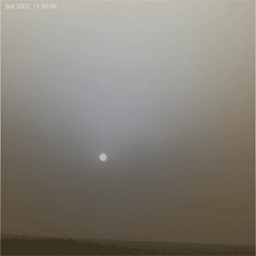 A dusty sunset on Mars
A dusty sunset on MarsWhile "mobility impaired" down at Troy, Spirit looked westward on the evening of its Sol 2002 to watch the Sun set. Before it reached the horizon, the Sun vanished into dust kicked up in a regional dust storm. This animation is composed of 11 Pancam frames captured over 12 minutes, artificially colorized to add drama.
Credit: NASA / JPL / Cornell / animation and colorization by Peter Greutmann
"Scientifically, it's been an outstanding month," Ray Arvidson, MER deputy principal investigator, of Washington University St. Louis summed up during an interview late last week.
While Spirit remains in the sand pit called Ulysses, just west of Home Plate, where it’s been embedded since early May, the rover has been working like crazy, uncovering more treasures in the trove at Troy, and sending home a rich collection of pictures and a wealth of data about its immediate surroundings. Amidst the light-toned sands of Ulysses, it has homed in on a sample containing more calcium than any other sample found so far on the mission. It's more solid evidence of water and more support for the scientists' hypothesis that these are deposits left after a volcanic explosion.
“These white and light-toned sands are late-stage hydrothermal deposits,” said Arvidson. "During waning volcanism, there were aqueous fluids, water fluids coming up from underground that were charged, and the sulfur and cations oxidized, leaving the sulfate deposits."
Like last month, a lot of the Spirit action in August took place on Earth as crewmembers continued testing exit maneuvers with ground rovers in the indoor Mars yard, officially called the In-Situ Instrument Laboratory (ISIL) at JPL. Though tests scheduled today were postponed, a lot of work was accomplished during the last four weeks in the sandbox – not so affectionately known as the dustbin.
Still, given Spirit's predicament and its broken right front wheel, this extrication isn't exactly going to be a cakewalk and "no clear winner" emerged as the exit strategy for Spirit during the first round of tests on the ground, Arvidson said. "We've done a lot of experiments in the sandbox with this diatomaceous earth and clay mixture and it appears what we're seeing on Earth would be a worst case scenario on Mars. Meaning, I think the wheels on the test rover sink in more than Spirit did up on Mars." That caused the Spirit team to consider another mix of simulated Martian sand.
Arvidson flew out to JPL, compared notes with the engineers, and together they took in recommendations from a review board during the middle of the month. “In the testing in the diatomaceous earth and clay mixture in the dustbin with our Surface System Test Bed rover (SSTB), everything we tried made progress – to a point,” said Laubach. "We would make progress, then plateau out. We don't know if this is something we're going to see on Mars or if it's an artifact of the tests we're doing.”
After the pow-wow with the review board, the Spirit team prepared for a new round of tests using both the SSTB and another lighter rover, called, appropriately enough, the SSTB Light. They would put both rovers through the series of extrication maneuvers in the sandbox and outside the sandbox in a simulated scenario on the crushed garnet "sand" that carpets the main floor of the Mars yard. The objective is to look at the rover's dynamics with differing “gravity” (weight) and with different Martian sand substitutes or simulatns. That's not all. They also decided to add a virtual model to the mix.
The MER project actually created a virtual rover years ago, before launch, using a commercial interactive, motion simulation software called ADAMS. "We're dusting it off," said Arvidson, pun intended, "and updating it." The plan is to put the virtual rover through the same maneuvers as the ground rovers and "run simultaneous equations" for kinematic, static, quasi-static, and dynamic simulations. Then, they will compare all the results, and pick the moves that they have calculated and qualified as being the most likely to get Spirit unstuck from Ulysses and out of Troy as safely as possible and onto its next destinations.
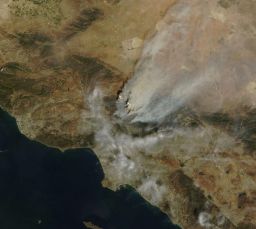 Terra MODIS image of the Station Fire
Terra MODIS image of the Station FireA detailed view of the Station fire burning in southern California at 18:45 UTC (11:45 local time) on August 30, 2009, from the MODIS instrument on the Terra satellite. Full imageCredit: Image courtesy of MODIS Rapid Response Project at NASA/GSFC
It's been a long process and word has been circulating that NASA officials are getting anxious for Spirit to get moving. A lot of rover fans are getting anxious, too. But Spirit's crewmembers seem to know well what they have to do and the MER team has a reputation for being meticulous about its research, as well as unwavering in its objectives. They've gotten the rovers this far by making very careful, thought-out decisions, and perhaps too, being a bit protective. All eyes are focused on the prize of freedom. It wouldn't make sense to change their methodology or rush their rover wrangling at this juncture. The last thing anyone on this team wants is a permanently stuck Spirit.
The difficulty lies in the complexity. It's not as simple as having Spirit "gun it," which is basically how Opportunity escaped Purgatory Dune way back when. One thing they already know for sure is that spinning the wheels can cause Spirit, which has a broken right front steering wheel, to sink in deeper into Ulysses.
Probably anyone here on Earth who's gotten her or his car stuck in sand knows that common reality. Just imagine if you had to direct your car out of sand from millions of miles away via remote control through a computer, not even a joystick, and one of your car's wheels was immobile.
“That's why we're being really careful and taking our time and being methodical about this,” offered Laubach. “We don’t want to be experimenting with this on Mars.”
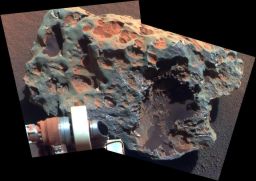 Block Island
Block IslandOpportunity took this picture of Block Island, the largest meteorite found to date on Mars, with its panoramic camera (Pancam). The rover checked out its composition with the alpha particle X-ray spectrometer (APXS) and confirmed that it is rich in iron and nickel. The rock is about 60 centimeters (2 feet) across. This is a false-color, red-green-blue composite view generated from images taken through the Pancam's 750-nanometer, 530-nanometer and 430-nanometer filters. The exaggeraged color is used for enhancing the visibility of differences among the types of rock and soil materials.Credit: NASA / JPL-Caltech / Cornell University
Once the rover planners settle on an exit strategy and begin to upload commands, Spirit's exit will be anything but swift. With the Martian sand in Ulysses and the slippery slope and Spirit's broken right front wheel, this extrication process, warned Laubach, is likely to take “a couple of months.”
But there is light at the end of the tunnel now. If everything comes together, Spirit could start moving again sometime in late September. Testing on the ground is still going to take "a couple more weeks," according to Arvidson. And then there is the dress rehearsal. But it could be Spirit's looking at a September to remember.
The engineers and scientists remain optimistic Spirit will be roving onward soon. Although he isn't downplaying the challenge, Arvidson still insists Spirit is only "mobility impaired," as he puts it. "We can do this and the morale necessary to do it is good, really good.”
Meanwhile, on the other side of the planet, Opportunity hung out all month on Block Island, the 70-centimeter (28-inch) hunk of rock its crew had diverted it to last month. During its month-long investigation, the rover used its alpha particle X-ray spectrometer (APXS) to confirm the rock is a meteorite. "There's no question that it is an iron-nickel meteorite," said Ralf Gellert of the University of Guelph in Ontario, Canada, the lead scientist for the rover's APXS. And, it's a blockbuster.
The size of a big watermelon, Block Island is actually the largest meteorite found to date on Mars. And, the scientists think this two-foot oblong rock is a heavyweight to boot, weighing as much as the rover weighs and harboring secrets about past Martian atmospheres. "The questions we're working on answering are: Is it corroded? And, does it have a fusion crust?" Arvidson said.
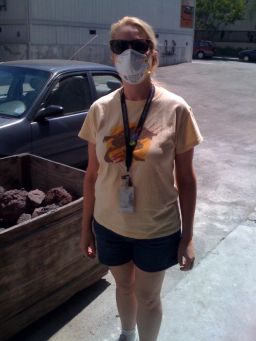 A smoke-prepared Sharon Laubach
A smoke-prepared Sharon LaubachIt's not just the rovers that go above and beyond the call of duty on the MER mission. In fact, neither rain, nor dust, nor smoke could keep the MER team from its robot field geologist teammates. Sharon Laubach, MER's integrated sequencing team chief, turned up prepared, as firestorms ignited all over southern California last week. The Lab closed on Monday, Aug. 31, because of smoke in the atmosphere. Plans call for JPL to reopen Sep.1. Credit: NASA / JPL-Caltech / Bill Nelson via iPhone
If it does have fusion crust, a thin, glassy coating on the surface that would be telling because such crusts are caused by intense heating during a meteorite's passage through the atmosphere.
“That [large] of an object would have a difficult time getting through the atmosphere as it is now at Mars, so if there is a fusion crust, that means it probably came down in a denser atmosphere billions of years ago," Arvidson explained.
Or, according to MER team member Matt Golombek, of JPL, Mars could possibly have hidden reserves of carbon-dioxide ice that supply large amounts of carbon-dioxide gas into the atmosphere, thus making for a denser atmosphere during warm periods of more recent climate cycles. Either way, sending Opportunity to Block Island was a good call.
While several small dust storms originated in Acidalia/Tempe region and a few of them tracked southward through Chryse/Xanthe and into the equatorial regions toward Opportunity, ultimately they did not move in. This rover, in fact, didn't appear to be impacted in any way by the August dust storms, even though it did experience "a slight dip" in power levels this month, according to Laubach.
As September falls in, both Spirit and Opportunity are in robust health, sporting plenty of power, and ready, willing, and able to ramp up in coming sols and move on.
Spirit from Gusev Crater
As the calendar turned from July to August, MER engineers and scientists began their fifth week of testing exit maneuvers with the surface system test bed (SSTB) rover in the In-Situ Instrument Laboratory (ISIL) at JPL. On Mars, Spirit began the month of August pretty much the way it’s begun the last two months -- with four of its wheels embedded in Troy, continuing its examination of the sandy soils around it with the tools on its robotic arm or instrument deployment device (IDD). But it was focused this month on taking a deeper look into the sulfate soils in which its left three wheels, and right rear wheel are embedded to get an even better profile of the geology at Troy and the sandy soils of Ulysses.
During the first sols of the month, Spirit used its microscopic imager (MI) to take pictures of Penina, the light-toned patch that was its first soil target in Ulysses, and spent hours checking out Cyclops’ Eye with the Mössbauer spectrometer, the German-designed and built instrument detects iron-bearing minerals in soil and rocks.
At the start of the mission, a good Mössbauer measurement took about 12 hours on average, however, since this instrument has a radioactive power source that degrades over time, it now takes in excess of 48 hours to get a good reading. The Mössbauer has its own microcontroller though, so measurements are often performed at night while the rover is “asleep.”
On Sol 1986 (August 4, 2009), Spirit prepared its rock abrasion tool (RAT) for grinding into Cyclops’ Eye. With 907 watt-hours, relatively clear skies, and about 82% of the sunlight hitting the solar arrays being converted to energy, the rover continued working day and night, acquiring a rich collection of pictures of the sky after dark.
It filled out the first week of the month with an illumination experiment. Essentially, it took a set of navigation camera observations at different times of the day to help scientists better examine texture in the terrain. This is the kind of imaging data that could help the MER team plot future driving, and maybe even help Spirit to avoid hazardous patches like Ulysses in the future.
Spirit launched into the second week of the month on Sol 1990 (August 8, 2009) by taking another picture of the pointed rock underneath it that seems to be touching its underbelly. Like it did in May and June, the rover reached underneath itself with its arm and snapped away. That same sol, it continued its science campaign of grinding deeper into selected surface targets to analyze multiple layers of soil at Troy.
With its rock abrasion tool (RAT), Spirit ground again into Cyclops’ Eye, a target located on the right side of the rover. Following that, the rover documented its work on what was freshly labeled Cyclops’ Eye 6 by taking pictures with its panoramic camera (Pancam) and microscopic imager (MI), like it had been doing as a matter of course. But when it attempted to place the Mössbauer on the surface, Spirit suffered a glitch known as a command sequence fault occurred in its arm. This fault, according to JPL engineers was a benign error that occurs from time to time because of very small positioning errors in the IDD.
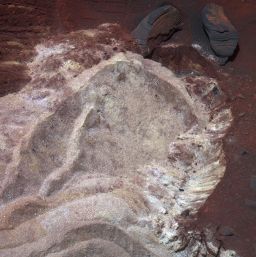 Ulysses in Troy
Ulysses in TroySpirit accidentally slipped into a sandpatch dubbed Ulysses in an area called Troy in April and became embedded by the first week of May. Inside the area, the rover churned up a mixture of light-toned soils unlike anything either rover has seen. The variations in this mixture are revealed in pastel hues visible in this panoramic camera (Pancam) image that has been stretched to emphasize the differences. The two rocks near the upper right corner of this view are each about 10 centimeters (4 inches) long and 2 to 3 centimeters (1 inch) wide.
Credit: NASA / JPL-Caltech / Cornell
Once the glitch was investigated, understood, and cleared, Spirit went back to grinding, performing a grind scan on Sol 1993 (August 11, 2009), then two sols later digging into Polyphemus’ Eye 2, another target located on the crustier ground on the right, upslope side of the rover. It then took more pictures with the Pancam and MI and collected more data on mineral content with the alpha particle X-ray spectrometer (APXS). The following sol, Spirit changed instruments and placed the Mössbauer on the target for an overnight integration or observation.
“We have ground in twice into Polyphemus’ Eye -- which is named for the Cyclops who got the spear in his eye -- and are now down a couple of centimeters and we don't see any white stuff at all,” said Arvidson. “We think now that the white and light-toned, sulfate soils begins on the left side, where the rover’s wheels are embedded.”
On Sol 1997 (August 15, 2009) Spirit turned its attention and the instruments on its arm to a white soil target in Ulysses called Olive Leaf. There, it took a series of pictures with its MI for a mosaic image, then followed up with an APXS analysis. The next sol, the rover put its Mössbauer back on Polyphemus for several more hours of observation.
When the Sun set on August 18, Spirit and its team cruised back into the record books as the rover completed its 2000th sol on the surface of Mars. Some of the MER team members took a break from operations at JPL to celebrate with the traditional sheet cake. It’s yet another major milestone in an ever-growing list of major milestones logged by the MER mission, but it wouldn’t be the only new record Spirit established in August. Just eight sols later, MER-A wrapped its third Mars year . . . a long, long way down the road from its original, three month expedition.
One Mars year is equivalent to approximately 687 Earth days. However, since a Martian day or sol is slightly longer than an Earth day -- about 24 hours and 39 minutes -- a Mars year is about 669 sols. Spirit will celebrate its sixth Earth year in January 2010.
In the midst of those achievements, the skies over Gusev began getting dusty and by Sol 2001 (August 19, 2009), it was clear that atmospheric conditions were deteriorating. Storms were swirling through the Arcadia/Amazonis region, reported the MARCI team at Malin Space Science Systems (MSSS) in San Diego. For the most part, those storms moved to the northeast with some "diffuse dust" also observed heading to the south in the general direction of toward Spirit, but they didn’t rain much dust on Spirit’s parade.
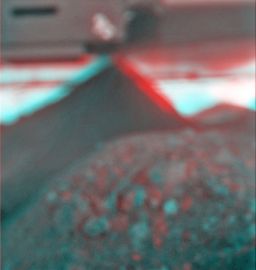 Looking underneath 3-D
Looking underneath 3-DRover team members used the MI's camera on the rover's arm to accomplish something never intended during the design of the robot or that camera -- getting a look underneath the rover. This stereo view combines a pair of images Spirit took two months apart with its short-focus microscopic imager. Even though they knew the image would be blurry, the MER team wanted to get a better look at Spirit's predicament. The dark triangular shape is a rock that appears to be touching the rover's underbelly. The two images combined here come from two camera positions, one slightly to left of the other, yielding a three-dimensional view when seen through red and blue glasses (red lens on left). One image was taken on Sol 1925 (June 2, 2009); the other Sol 1990 (Aug. 8, 2009).
Credit: NASA / JPL-Caltech / USGS
Then, a storm that developed south of Elysium, to the west of Spirit, turned into a significant regional event. As it moved east toward Gusev on Sol 2005 (August 23, 2009), it turned the skies over Spirit hazy and took quite a bit of "wind" out of the rover's “sails.” Power levels quickly dropped from more than 900 watt-hours to 744 watt-hours. The atmospheric opacity or tau increased to 0.718. The dust factor, however, remained around 0.8315, meaning 83% of the sunlight beaming down was penetrating the solar panels and being converted to energy. Given the weather report, the team knew that wouldn’t likely last.
Back at JPL, Spirit’s extraction crew began a long-duration experiment with the SSTB rover as the third week of August took hold. Earlier tests ran for one or two days, but this experiment called for driving the rover for several hundred meters’ worth of wheel rotations over the course of a week or more without starting over, but changing steering direction several times during the run. In between tests, the team reset the sandbox to simulate Spirit's current starting position at Troy. The objective was to check whether favorable motion seen in earlier tests could be sustained to gain as much distance in the sandbox as Spirit would have to gain on Mars to escape the grip of Ulysses.
No clear strategy, however, was emerging from the weeks of testing. "There is no perfect Earth analog for Spirit's current situation," said JPL's John Callas, MER project manager. "There's less gravity on Mars, little atmosphere, and no moisture in the soil where Spirit is. It is not anything like being stuck in sand or snow or mud on Earth. Plus, since the rover moves only about as fast as a tortoise, you cannot use momentum to help. No rocking back and forth as you might do on Earth."
Arvidson flew out for the review board, which analyzed and considered the work done in the ISIL so far. From that and the discussion that ensued, a new plan was put on the agenda. Before trying to decide which maneuvers to send up to Spirit, they would conduct another round of tests with a second, lighter-weight rover. And, they would put the second test rover, known as the SSTB Light and the heavier SSTB, through the exit moves in two different soil simulants, the diatomaceous earth and clay mixture the crew has been using and the tougher, crushed garnet aggregate that carpets the main floor of the In-Situ Instrument Laboratory (ISIL), which offers better traction.
Just like its name implies, the SSTB Light is not as heavy as the SSTB rover. On Earth, the SSTB is heavier than Spirit is on Mars; whereas, the SSTB Light is closer to the weight of Spirit on Mars. There are other differences too. While the SSTB rover uses the exact same flight software and same command set as Spirit and Opportunity do on Mars, the SSTB does not. “We can't command it in the same way as SSTB,” Laubach noted. Actually, the SSTB Light is, the engineers say, much easier to drive, because it's more like a remote control vehicle, so they think they’ll get better performance. “It is a lot easier to fine-tune what we're doing with the SSTB Light,” she said.
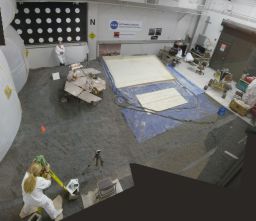 Mars on Earth
Mars on EarthOn August 25, 2009, on the MER side of the In-Situ Instrument Laboratory at JPL, rover engineers were test-driving the engineering model of the rover, known as the Surface System Testbed or SSTB, on a sloping surface composed of coarse sand. Next to it sits the sandbox containing a mixture of materials designed to simulate the behavior of the soil in which Spirit's wheels are embedded on Mars. In the foreground, engineer Sharon Laubach uses a theodolite to measure the SSTB's position after a test of driving in a crablike motion. In the background on the right, the SSTB Lite, a stripped down, Mars-weight engineering model of the rover, waits to perform similar tests.
Credit: Emily Lakdawalla
A point of possible interest: the SSTB Light has been around the block in the Mars yards at JPL. It was actually one of the first rovers that the original MER engineers outfitted with equipment for conducting the initial mobility tests back in the days of development, according to Jake Matijevic, chief of the rover engineering team. “It didn't have payload elements on it and only a couple of cameras and was actually better suited for doing some of the first-level drive testing back then,” he said. “It was also used for things like rehearsing the release and stand-up procedure when the rovers were still on their landers, and we prototyped a lot of the Endurance Crater driving on it, simulating how we would go up and down the crater walls.”
Making comparisons between motions of the SSTB rover and the SSTB Light rover in duplicated drives will help the rover team in interpreting effects of differing gravity on rover mobility, Arvidson said. And comparing the two Martian sand simulants -- the powdery diatomaceous earth and clay mix, and the stronger crushed garnet -- will help the team better anticipate how the real Martian sand will respond.
“Ray came out and looked at the diatomaceous earth and clay mix we have in the dustbin and the behavior of the SSTB in that and agreed that it looked like a worse case compared to what we're seeing on Mars,” said Laubach. “He thought the crushed garnet aggregate on the floor of ISIL, might show behavior more like what we have on Mars.”
So they tilted the main, tiltable floor in the ISIL, creating a 10-degree slope, then sculpted Spirit’s scene in the aggregate to match what's in the diatomaceous earth-clay mixture in the dustbin, and let the testing begin. “We're doing these new material tests in a very limited area, because we have very tight space on this aggregate,” Laubach pointed out.
First, they put the SSTB rover through the paces in the soil simulant. The engineers commanded it to conduct all the primary maneuvers like driving forward, Spirit-style backwards driving -- “which is slightly arced to compensate for the right front wheel,” reminded Laubach -- crabbing, and a turn in place. Then they put the SSTB in the crushed garnet aggregate and did the same thing.
Last Wednesday, August 26, the MER engineers put the SSTB Light in the aggregate and repeated the sequence of maneuvers, following those tests with tests in the diatomaceous earth and clay mix.
 Reviewing options
Reviewing optionsOn Aug. 7, 2009, MER engineers and scientists together reviewed results from the ground-based tests of possible exit strategies for Spirit. The rover has been "mobility impaired" since the first week of May, caught up a wicked patch of light-tone sand. Further testing at JPL was planned this month before the team will command Spirit to begin moving again. In this image from the review session, JPL engineers Frank Hartman and Jake Matijevic view a projected map of Spirit's location at Troy.
Credit: NASA / JPL-Caltech
They also changed how they were measuring the small, centimeters of progress. “Instead of the types of measurements that we've done before,” Laubach said, “we're now using a modern, optical surveyor's tool, a total station, in order to get even more precise measurements.”
The MER team is calling this latest round of exit investigations the "four corners" test. “We vary gravity and vary material properties,” said Arvidson.
“It's the two different weights of the test vehicles – SSTB and SSTB Light – and soil simulant versus aggregate,” Laubach elaborated. “Ray thinks the diatomaceous earth and clay mixture is resulting in outcomes that are worse than what we see on Mars and he suspects the aggregate will be better, so we're bracketing.”
What was missing from the extraction testing equation, as the last review board saw it, is “the mapping from kinematics or motion to dynamics,” Arvidson explained. Which, simply put, is understanding the motions. “The last review board said we needed to do a better job of going from motions to understanding dynamics. The four corners test will allow us to really focus in on mapping from kinematics to dynamics by changing the magnitudes of the variables, changing gravity, changing cohesion, changing angles, and internal friction.”
Kinematics, by definition, is the branch of classical mechanics that describes the motion of objects without consideration of the causes leading to the motion. It is sometimes subdivided into kinetics, the study of the relation between external forces and motion, and statics, the study of the relations in a system at equilibrium.
In the first round of tests with the SSTB in the dustbin, virtually every maneuver made progress -- for a while. “If we start driving straight forward, we make good progress, then a little less and a little less until we're plateauing out,” explained Laubach. “But then if we steer, say, to crab uphill, we make good progress again until that plateaus out. If we drive forward again, we seem to move on again. Everytime we change the steering, it seems to alter the conditions so we can break out of the plateau.”
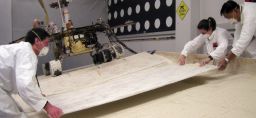 Laying the groundwork
Laying the groundworkA test setup at the Jet Propulsion Laboratory enables the MER team to conduct experiments with maneuvers being considered to help Spirit get out of the oft soil where it has become embedded. In this image from Aug. 12, 2009, rover team members are moving a board used in getting the setup ready for the next test. From left: Matt Van Kirk, Julie Townsend, Tam Nguyen. Once the board is in place, the test crew applies weight to it to moderately compress the mixture of clay powder and diatomaceous earth being used as a simulation of the Martian soil underneath Spirit. Credit: NASA / JPL-Caltech
Since they don't know if this plateauing out is an artifact of the tests on Earth or something that is likely to happen on Mars, they decided to test the exit maneuvers with a virtual rover, as well as the SSTB and SSTB Light rovers.
Arvidson called on Randy Lindemann, one of the original mechanical engineers on the mission who had developed a virtual MER years before, and together they have been setting up a full dynamical virtual model of the embedded Spirit in simulation software called ADAMS.
Basically, the ADAMS software allows engineers to build and test virtual prototypes, then realistically simulate given situations in the computer, both visually and mathematically. The software checks the model and automatically formulates and solves the equations of motion for kinematic, static, quasi-static, or dynamic simulations. Lindemann utilized the ADAMS software pre-launch in drop tests to simulate landing with the airbags, and has used it since to simulate other rover motions. This time around, said Arvidson, they’ll use it “to run the rover across the simulated terrain” to validate any of the preferred exit strategies.
“The ADAMS modeling allows us to simulate the motion of the vehicle on topographic surfaces with various materials,” expounded Arvidson, who is providing Lindemann with a detailed topographic map of the area and estimates of material properties. “We're using ADAMS to try and replicate the drives and behavior to better understand the physics happening, along with the gravity and material properties. That will help us I think in terms of defining the right extraction path.
One thing the Earth testing has unequivocally confirmed -- something which correlates with what had been happening on Mars before Spirit stopped driving -- is that “spinning the wheels causes the rover to sink,” said Laubach. That is exactly why they decided to stop driving Spirit last May. It is also the main reason they’re going to such effort to come up with just the right series of maneuvers. “We want to understand as best as we possibly can what's going to happen on Mars, so that we don't sink in any further,” she said.
At this point, the engineers are not leaning toward any specific set of extraction maneuvers, or, if they are, they’re not saying what they are. “We have a couple of reviews coming up and we’re all being extra cautious,” said Laubach. The leading contender as of last month was to start driving straight forward, then crab uphill watching for progress, then if progress plateaus, drive forward.
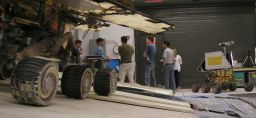 Doubling up test rovers
Doubling up test roversTesting at JPL in August 2009 continued testing possible maneuvers Spirit might use for escaping from a patch of soft soil where it is embedded at a Martian site dubbed Troy. In this image from Aug. 21, 2009, members of the rover team at JPL plan for starting to use a second rover in the set-up. The Surface System Testbed Lite (far right) is not as heavy than the primary engineering test rover, called the Surface System Testbed or SSTB(left foreground). The lighter version does not carry a full science payload and robotic arm, as Spirit, Opportunity and the SSTB do. Making comparisons between motions of the two test rovers in duplicated drives will aid the rover team in interpreting effects of differing gravity on rover mobility. An object that weighs 10 pounds on Earth weighs just 3.8 pounds on Mars, due to the smaller mass of Mars compared to Earth.
Credit: NASA / JPL-Caltech
Interestingly, all the testing combined with Spirit’s investigations on Mars, has provided some confirming forensic evidence about what happened as the rover neared Troy back in April.
“When we drove here around Sol 1871, the vehicle yawed a little bit relative to the preferred drive and we ended up on this slope,” recounted Arvidson. “Based on everything we've done, Spirit wound up in this mess because of that 12-degree roll or yaw to the west,” he said. “We just got into the wrong place at the wrong approach, because of this drift in yaw during the drive.”
They’ve also discovered that the crust or top layer of the terrain where Spirit’s left three wheels are embedded is not as thick as it is on the right side [upslope side] of the rover, where its right front wheels are.
“The top layer actually thickens to the right,” said Arvidson. They know that now because of Spirit’s two grinds into Polyphemus' Eye, located near the right wheels, and a detailed analysis of what the right rear wheel, which, like the left three wheels is embedded, was doing when it got bogged down. “The rover dug a pretty good trench and there's no light-toned stuff in there,” Arvidson said.
“The white stuff is not on the right side. It's only on the left,” Arvidson continued. “So I'm thinking it's more like Tyrone, Dead Sea, and Paso Robles, high sulfate-rich material forming in low areas. This is what you find during the last stages of eruption, where the water table is just coming up to the low areas. It's the model we're using to flesh out terrain material properties for the ADAMS simulation. When we extricate, we want to avoid the material downhill of us – probably. But we need to validate all this.”
While Spirit’s crew continued working its exit in the ISIL, the rover continued collecting more data. On Sol 2005 (August 23, 2009) it used its Pancam to examine the nature of how soil at the site has stuck to the rover's middle wheels, then on the following sol used the RAT as a penetrometer to measure physical properties of the soil, pressing into a chosen patch inside Ulysses with three different, pre-load levels of force to directly measure its physical properties. After each press, the rover documented the resulting indentation with a set of images.
“We pushed the RAT into the sand in Ulysses to figure out as a function of pressure how far it would sink,” said Arvidson. “That's important for modeling sinkage associated with the soft material in the drives. We pushed into Ulysses three times with three different forces and the name of the target is Ulysses_Spear,” he added.
That same sol, Sol 2006 (August 24, 2009), Spirit collected an atmospheric argon measurement with its APXS, then placed its Mossbauer to take another few hours with of observations over the next several sols.
 Calypso Panorama
Calypso PanoramaSpirit took the images for this full-circle view with it panoramic camera (Pancam). It shows the terrain surrounding the location called Troy, where Spirit became embedded in soft soil, called Ulysses, in May this year. The rover began taking the hundreds of images combined into this picture beginning on its Sol 1906 (May 14, 2009), finishing on Sol 1943 (June 20, 2009).
North is at the center; south at both ends. The western edge of the low plateau called Home Plate dominates the right half of the panorama. At the far right is a bright-topped mound called Von Braun, the planned next stop for Spirit. Near the center of the panorama, in the distance, lies Husband Hill, where the rover recorded views from the summit in 2005. The ridge on the left, near the rover tracks leading to Troy from the north, is called Tsiolkovsky. For scale, the parallel tracks are about 1 meter (39 inches) apart. The bright soil in the center foreground is Ulysses, the patch in which Spirit remains embedded. The composition of different layers in the soil at the site have become the subject of intense investigation.Credit: NASA / JPL / Cornell University
As August progressed, so did the dust storms on Mars. The Elysium storm pushed its dust southward over Gusev during the last week of the month and the rover’s power levels fell dramatically, from 900+ watt-hours at the beginning of the month to 322 watt-hours on Sol 2007 (August 25, 2009). The atmospheric opacity or tau increased to 2.61. [A 5.0 tau would be effectively a blackout, or perhaps more accurately a redout, and .5 is about average, sans dust storms, for this time of year.]
The dust factor for Spirit declined to 0.658, meaning that about 65.8 percent of the sunlight hitting the solar array was being utilized and converted into rover energy. It was a steep and sudden drop, but power levels in the 300s is still generous compared with the 200 to 240 watt-hours per sol that was typical for Spirit for so long, until wind gusts cleared the accumulated dust from the rover’s solar arrays in recent months.
The rover handlers responded to the power drop by trimming Spirit's daily activities while continuing to monitor the weather reports from MARCI and Mars Climate Sounder on MRO. Since wind gusts in May, June, and July cleared almost all of the dust coating its solar panels, the rover had been working long hours in the weeks before the storms. It had to really, to burn up the abundance of energy it had. “Spirit had so much power, we even worried about it overheating,” said Laubach. With the sudden, drastic drop in energy, overheating was no longer a concern. All energy intensive tasks, specifically the night sky photography campaign, were put on hold.
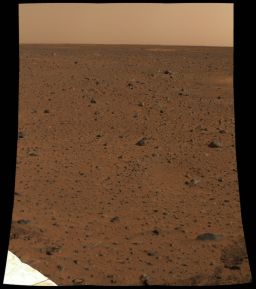 First look . . . celebrating 3 Mars years
First look . . . celebrating 3 Mars yearsNot long after bouncing down to the surface, Spirit used its Pancam on Sol 2 (Jan. 4, 2004) to snap this image of its surroundings. The twelve frames in this view make up the mission's first, rover-acquired color mosaic of Mars. The scene rises from near the edge of the lander platform to the sky. Near the platform, evidence of the airbag retraction is preserved in the surface, notes Jim Bell, Pancam lead and President of The Planetary Society. Pancam's 753-nanometer, 535nm, and 482nm filters were used in this mosaic. Credit: NASA / JPL-Caltech / Cornell University; mosaic by Elaina McCartney, J.R. Skok, Jonathan Joseph
By the very next sol, however, Sol 2008 (August 26, 2009), Spirit’s power levels seemed to be on the rise, registering at 345 watt-hours as the tau dropped to 2.46. The signs seemed to be indicating the worst of the storm was over. “The weather prediction from the Mars Color Imager team is that the storm is abating, but skies will remain dusty over Spirit for the next few sols,” John Callas, MER project manager, announced last week. "Spirit remains power positive with healthy energy margins and charged batteries,” he added.
Then, again, consider the sol. Maybe the immediate bump back up was caused by pride power -- for on Sol 2008 Spirit finished its third Mars year. Who’s to argue with these rovers?
“The question now is how much dust will be left on the panel and what the transmission factor will be and what our date will be for parking for winter,” said Arvidson. “We just have to wait and see,” added Laubach.
Unfortunately, there aren’t any more weather reports streaming down from Mars right now. On August 26, hours after the MER team got its regular weather update from the MARCI team at Malin Space Science Systems (MSSS), MRO went into safe mode and all cameras and instruments were shut down.
“The spacecraft is stable,” MRO Project Manager Jim Erickson said last Friday. “Our priority now is to carefully work our way to understanding this anomaly, with the intent of preventing recurrences.” Power, temperatures and battery charge are all “within normal limits or higher,” he noted, so there is no danger or immediate threats to the orbiter’s instruments.
As August gives way to September, scientists and engineers will be looking very carefully at the results of tests conducted in the ISIL and in the ADAMS software. They will factor in what they learn from Spirit’s findings on Mars, of course, especially data from the Ulysses_Spear experiment that looked at the physical properties of the light-toned sulfate sands. “We’ll also be figuring out whether we should make any changes to the test bed,” said Laubach.
Then, they will pick the best possible set of maneuvers that will allow Spirit to rove out of Ulysses, away from Troy, and on to Goddard and von Braun, the house-sized pit and unusual mound just to the south of Home Plate. “The target date for extraction on Mars now – and of course this may slip,” cautioned Labach, “is mid-September.”
The pointed rock that looks like it’s right up against Spirit’s belly will probably remain an unknown and complicating factor until the rover moves, even though it’s reached underneath with its IDD and snapped several pictures with its MI, the latest one earlier this month. “We're on a cluster of rocks, but most of us don't think the rocks are an issue because they're small and probably not actually touching the vehicle,” said Arvidson. “I suspect if we drive back or forward those rocks will just rotate and move as the rover moves.”
While everyone hopes that’s true, rover drivers and planners have to be concerned. It’s their job. “If that is a large, solid, entrenched rock and it doesn’t move, and if we get the point of the rock under the center of gravity (CG) of the rover, we're out of luck,” explained Laubach. “If the CG of the rover is balanced on that rock, we won’t be able to get any traction. That's why the rover planners are being very cautious about what they're putting forward as their extraction plan. They want to take into account all of these things – the sinkage, the possibility of high-centering, the possibility of getting the rock entangled with the IDD shoulder joint, everything,” she said.
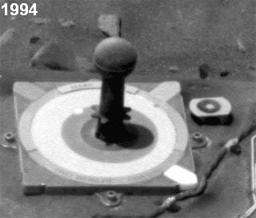 Shadows change with the dust storm
Shadows change with the dust stormSpirit took six images of its Marsdial calibration target from its Sol 1994 to sol 2012 toillustrate the effect that a regional dust storm had on lighting conditions in Gusev Crater. On Sol 1994, skies were quite clear, so the shadow of the Marsdial's gnomon was dark. But as dust filled the skies, sunlight dimmed at the same time that more light was scattered into shadowed areas, making the shadow considerably lighter and more diffuse. By sol 2012, conditions were improving, and the shadow darkening again. The Mars Dial was a contribution of The Planetary Society.
Credit: NASA / JPL / Cornell / animation by fredk
Spirit's escape from Ulysses is not going to be easy. And it’s not going to be anything like Opportunity’s exit from Purgatory Dune back in 2005. Opportunity basically put it in reverse and hit the pedal. “Spirit’s extrication is a lot more complicated,” said Arvidson. “We’re still doing tests, so the question remains -- drive where and how without becoming further embedded?”
Remember too that Spirit has a disabled right front wheel that is locked in place and has to be dragged like an anchor. That makes Spirit a 5-wheeled rover and that issue alone is significant, even without the powdery Martian sand and slippery slope. “We understand the situation we're in on Mars and we want to preserve our rover,” said Laubach. “We've got very tight budgets and are pretty short-handed now trying to operate all the rovers at the same time.”
Not to mention that some of the team members are also doing double-duty on the next rover slated to fly, Mars Science Laboratory (MSL). “We have the number people we have and things just take the time they take.”
In coming days, Spirit’s extraction team will conduct a two-week "dress rehearsal,” during which they will drive the test rovers as far as Spirit would have to drive on Mars to escape the sands of Ulysses. Even when they begin sending commands to the rover to begin extricating itself, the process will be extraordinarily slow. “Once we get started, we expect that it’s going to take a couple of months before Spirit gets out,” said Laubach. “The team understands that and they're all cheered by the progress we've seen.”
“While this is not going to be easy, we do have the wherewithal to do this,” added Arvidson.
Up on Mars, Spirit’s odometer still reads 7,729.93 meters (4.80 miles). Although it’s spent the last four months “mobility impaired,” Troy has continued to be a trove of treasures and more, Arvidson confirmed. “It continues to be one of the best places we’ve been on the entire mission to make detailed measurements.”
Spirit’s most recent analysis on a little chunk of a white sandy target called Olive Leaf at the top of Ulysses has uncovered another mission gem. “It’s far and away the best end member for the light-toned material beneath the red material on the left side of the rover, having more calcium associated with the sulfur than we've seen anywhere before,” Arvidson said. “You can't get any closer to following the water.”
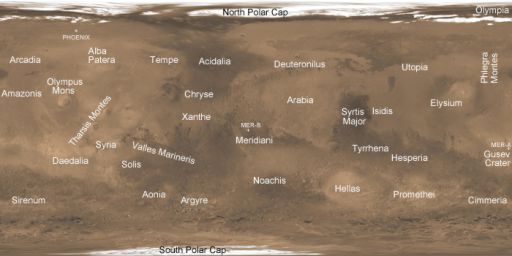 Reference map
Reference mapThis reference map of Mars was taken by the Mars Color Imager (MARCI) camera onboard the Mars Reconnaissance Orbiter (MRO)and processed and labeled by the team at Malin Space Science Systems. It shows Martian locations frequently mentioned in weather reports from the Red Planet.Credit: NASA/JPL-Caltech/Malin Space Science Systems
Opportunity from Meridiani Planum
Opportunity arrived at the large, chunky 2-foot oblong cobble called Block Island late last month, right as July was coming to an end. The rover made a short bump or move of about 1.5-meters (5-feet) on Sol 1961 (July 31, 2009) to put the big, watermelon-sized stone in the work volume of its robotic arm or instrument deployment device (IDD).
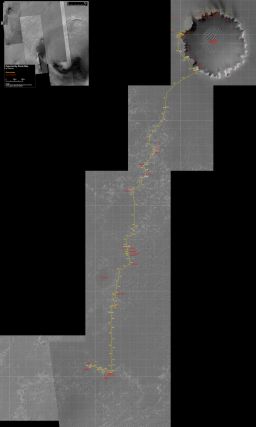 Opportunity route map
Opportunity route mapThis composite of images taken with the HiRISE camera onboard the Mars Reconnaissance Orbiter has been labeled to show Opportunity's route since leaving from Victoria Crater. The marked route comes courtesy of Eduardo Tesheiner, a member of UnmannedSpaceflight.com. Credit: NASA / JPL-Caltech / UA / Eduardo Tesheiner
On the first sol of August, it was ready to rock. Opportunity began the month with a series of studies on chosen surface targets. From Sols 1963 to 1967 (August 1 to August 5, 2009), the rover used its MI camera and spectrometers to analyze the composition of Block Island. On Sol 1968 (August 6, 2009), the rover put its Mössbauer spectrometer on the meteorite surface on a target called New_Shoreham for a multi-sol analysis. It didn’t take long before the scientists’ suspicions were confirmed.
Based on its surface texture and the analysis of its composition from the alpha particle X-ray spectrometer (APXS), the scientists quickly determined that Block Island is an iron-nickel meteorite, according to Ralf Gellert, of the University of Guelph, Ontario, Canada and APXS lead scientist.
Back in late 2004, Opportunity found a smaller iron-nickel meteorite, nicknamed Heat Shield Rock because it was near the heat shield the rover discarded on landing. But Block Island is blockbuster big and its sheer size is its most immediately impressive quality. Measuring in at about 60 centimeters (2 feet) across and weighing in at an estimated half-ton or more, Block Island is roughly 10 times as massive as Heat Shield Rock. It is the largest meteorite found on the mission to date, loaded no doubt with stories to tell.
Block Island is, the scientists say, too big several times over to have come through the Martian atmosphere as it is today and landed intact. That makes it something of a Martian mystery -- and the MER scientists love a mystery.
Atmosphere, of course, slows the descent of meteorites as well as spacecraft, and if Block Island were to come through Mars’ thin atmosphere today, it would disintegrate. "Consideration of existing model results indicates a meteorite this size requires a thicker atmosphere," said MER team member Matt Golombek, of JPL. "Either Mars has hidden reserves of carbon-dioxide ice that can supply large amounts of carbon-dioxide gas into the atmosphere during warm periods of more recent climate cycles, or Block Island fell billions of years ago." Time and more research should tell which is most likely the case.
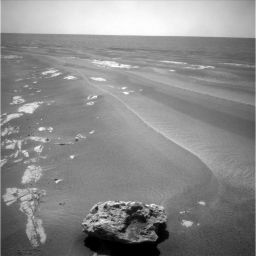 Block Island
Block IslandOpportunity spent the month of August checking out Block Island, a large, big watermelon-sized dark cobble, about 0.6 meters (2 feet) acorss that turned out to be an iron-nickel meteorite. The team spotted the rock on July 18, 2009, located in the opposite direction from which the rover was driving. Igt was so intriguing they instructed Opportunity to backtrack some 250 meters (820 feet) to study it closer.
Credit: NASA / JPL-Caltech
Meanwhile, the close-up pictures of Block Island that Opportunity took with its microscopic imager (MI) reveal a distinctive triangular pattern in the surface texture, matching a pattern common in iron-nickel meteorites found on Earth.
"Normally this pattern is exposed when the meteorite is cut, polished and etched with acid," said Tim McCoy, a MER team member from the Smithsonian Institution, Washington D.C. "Sometimes it shows up on the surface of meteorites that have been eroded by windblown sand in deserts, and that appears to be what we see with Block Island."
A smaller, 15-centimeter (6-inch) iron-nickel meteorite found near Fort Stockton, Texas in 1952 -- now in the collection of Texas Christian University -- shows a similar surface texture to some portions of Block Island’s surface and a similar triangular pattern.
Called the Widmanstatten pattern, this triangular pattern was formed more than 4.5 billion years ago as the metal cooled. One iron-nickel mineral, kamacite, formed thin layers along the surface of crystals of another, taenite, which contains less nickel. The two minerals differ in their resistance to etching by acid or erosion by wind-blown sand, so those processes can make the pattern visible. Long exposure to wind-blown sand has brought out the texture on both the Fort Stockton meteorite and apparently on the Block Island meteorite on Mars.
Opportunity continued its investigation of Block Island as the second week of the month got underway. On Sol 1970 (August 8, 2009), the rover moved its Mössbauer to a new target on the meteorite’s surface called Clayhead Swamp. Already several spots have shown elemental variations on the surface, informed Gellert. “This might tell us if and how the metal was altered since it landed on Mars," he said.
Differences on the surface of this meteorite could result, for example, from interaction between it and the Martian environment. The metal could have become more rusted, for example, from weathering with longer exposures to water vapor or liquid.
The MER scientists are less interested, however, in studying the meteorite in and of itself. Instead, they’re focused on what it might say about where it’s been. "We have lots of iron-nickel meteorites on Earth. We're using this meteorite as a way to study Mars," said Albert Yen, a rover team member at JPL. "Before we drive away from Block Island, we intend to examine more targets on this rock where the images show variations in color and texture. We're looking to see how extensively the rock surface has been altered, which helps us understand the history of the Martian climate since it fell."
Opportunity bumped backwards and then re-approached Block Island with a 2.5-meter (8-foot) movement on Sol 1973 (August 12, 2009) to check out some pebbles next to the meteorite and to line up for new targets on Block Island. The next sol, it used its MI to take a mosaic of pictures of those pebbles scattered right at the foot of Block Island, now dubbed Vail Beach.
On Sol 1975 (August, 14, 2009), Opportunity bumped closer to Block Island by about 40 centimeters (16 inches), so it could reach other surface targets with its arm. It used its MI the following sol to take pictures of a spot called Purple Patch for a mosaic, then placed the Mössbauer spectrometer on the target for a long integration.
The rover repeated the process on Sol 1979 (August 18, 2009), taking pictures of a different target, only this time it placed its APXS on the target for compositional analysis. Two sols later, Opportunity performed a very small rotation to move its arm in azimuth to reach new targets on Block Island. On Sol 1982 (August 21, 2009), it used its MI to take pictures of the new targets, including Siahs Swamp, which it also examined with the APXS.
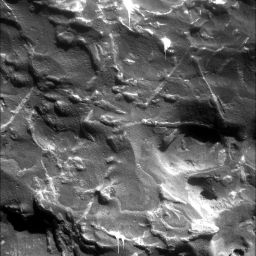 Block Island up close
Block Island up closeOpportunity used its microscopic imager to get this view of the surface of Block Island on its Sol 1963(Aug. 1, 2009). The triangular pattern of small ridges seen at the upper right in this image and elsewhere on the rock is characteristic of iron-nickel meteorites found on Earth, especially after they have been cut, polished and etched. Block Island has been identified as an iron-nickel meteorite based on this surface texture and analysis of its composition with the alpha particle X-ray spectrometer. At about 60 centimeters (2 feet) across, it is the largest meteorite yet found on Mars. This image shows a patch 32 millimeters by 32 millimeters (1.3 inches by 1.3 inches)Credit: NASA / JPL-Caltech / Cornell / USGS
The rover changed tools on the following sol, putting its APXS away and placing the Mössbauer on Siahs Swamp2 for a long analysis over several sols. On Sol 1986 (August 25, 2009), Opportunity retracted the Mössbauer to begin an ambitious MI imaging campaign that included taking color stereo images of Block Island’s surface with its panoramic camera (Pancam). Then, it put the Mössbauer back on Siahs Swamp2 for continued analysis.
The scientists are trying to determine if Block Island has a fusion crust -- which it would have acquired on the ride through the atmosphere -- and whether it’s corroded. “They've done extra long Mössbauer observations to determine if it does have the fusion crust,” Laubach said. The results have not yet been announced. “We are still in the middle of measurements,” said Arvidson.
Once Opportunity finishes its close-up examination, the plan is to have the rover drive around Block Island. “The scientists want to create a 3-D model of this meteorite,” informed Laubach. “Because of all the shadowing and all the cracks and everything, we'll be taking images at different times of day and with the MI to look underneath to get as complete a view of this meteorite as possible,” she said.
Throughout the month, the miniature thermal emission spectrometer (Mini-TES) shroud was again routinely left open in hopes the Martian winds would initiate a gust that could sweep into the instrument’s elevation mirror and clear the dust that’s coating the optics. But no improvement in the instrument’s performance has been observed so far. Still, like last month and the month before, Opportunity hasn’t seen any real wind events.
Having been at Block Island all August, Opportunity has been able to give its “hot” right front wheel a good long rest. Through all the little bumps and its right front wheel has been fine and its motor or actuator has drawn no more current than the others. “Because of the broken should joint in its arm, we have to move the rover now to re-position the IDD from side to side, so we have done short bumps to place the IDD with the frozen shoulder joint and in all those the wheel has been behaving very well,” she said.
Once Opportunity's work at Block Island is done, the rover will resume driving to the still distant Endeavour Crater.
Support our core enterprises
Your support powers our mission to explore worlds, find life, and defend Earth. You make all the difference when you make a gift. Give today!
Donate

 Explore Worlds
Explore Worlds Find Life
Find Life Defend Earth
Defend Earth


